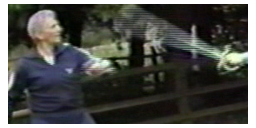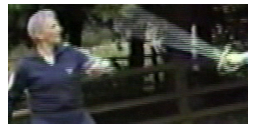Progressive and Interlaced

There are two basic formats for video, progressive and interlaced. Film is a progressive source because each picture fills the entire frame. That means the framerate is the number of individual pictures. Analog video, on the other hand, uses interlaced, or field based, video. Interlacing uses two different pictures to fill an entire frame. One field (picture) is drawn using every other line on a television screen, followed by a second field that's drawn on the lines skipped by the first. The fields are said to be interleaved together or interlaced. Like with film, each picture is from a different moment in time. Unlike film, the rate of individual pictures is twice the framerate.
While film only has progressive frames, and analog video only interlaced fields, digital video may have either or both. In the digital domain displaying progressively is a property separate from the contents of the frame. Although it's possible to encode and store interlaced video as a stream of fields, in reality this is rarely done. Most interlaced video is encoded in pairs in the form of frames. Although this is less efficient than true field based encoding, it's also simpler to design hardware for, making it a useful standard. As a rule, frame based interlaced encoding is less efficient than progressive encoding. This means that files with comparable bitrates will have lower quality if they contain interlaced video.
Field Conventions
When referring to interlaced fields there are different names given to each field in a pair. It's not important which convention you use, but it's a good idea to be consistent to avoid confusion. Sometimes the fields are referred to as even (lines 0,2,4,6,etc,...) and odd (1,3,5,7,etc,...), top (includes top line) and bottom, upper and lower, or even a (top) and b (bottom). I prefer even and odd personally because it conveys the interlaced nature of the fields better, but the most common convention is probably top and bottom.Spatial and Temporal Order
The pictures that make up interlaced fields have a correct order relative to each other. In fact there is both a spatial order, meaning which should be the top or bottom field, as well as a temporal order, or which one represents an earlier moment in time. If either one or both of these is incorrect it can cause playback problems from jerky motion to blurred edges.
Field Dominance / Field Order
Either the top or bottom field of an interlaced frame will be displayed before the other. The field played first is considered the dominant field. This can be abbreviated to indicate which field (top or bottom) is first temporally. If the top field plays first the video is Top Field First, or TFF. This is also known as field order. Video with a dominant bottom field is considered Bottom Field First or BFF. Since field dominance is normally set by a flag of some kind for every video stream, it can generally be changed with no loss of quality to the video because no re-encoding is required.Field Polarity
The fields that make up a single interlaced frame also have a spatial relationship to each other. The position of details in one frame is slightly different, either higher or lower, than the details in the other. This position is referred to as polarity, either top or bottom. This is important because in some cases fields can get reversed so that the top field is encoded as the lower field in a frame and the bottom field at the top. In such cases field dominance may or may not also be incorrect. The image on the left shows a portion of a frame with correct parity (ie fields in the correct spatial positions). Notice how much more detail you can make out in the man's face compared to the image on the right with reversed polarity.


